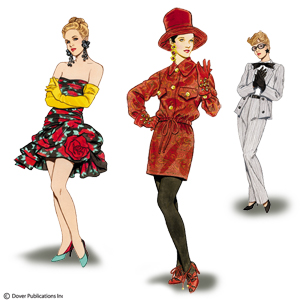Resources / Centuries and Decades / 1980s

1980s
In the 80s names and labels were put everywhere and on everything: never before had the consumer been attaching such importance to these attributes as it was in the eighties. "Dress for success" motto was as acute as never before, and the designer label became the most simple and effective way to show the financial solvency and the social status. Fashion houses could not depend any more exclusively on individual clients. Fashion designers have joined this "game of labels" and were getting enormous profits selling ready-to-wear clothes under their own brands, accessories, licenses and franchises.
Yuppies became one of the main categories of society the fashion industry was geared to. Their "diehard pragmatism" defined the attitude of the decade. In the eighties it was fashionable to earn money and to recklessly spend them, to dress well and to bathe in luxury, denying oneself nothing in excesses.
In the office Yuppie dress followed the so-called "authoritative style": the conservative cut and color of suits with huge shoulder pads - were characteristic both for men and women. Such strictness was compensated with luxury and brightness of accessories, which have acquired great importance in image making.
Pumps were the most widespread footwear for women. Designer Manolo Blanik popularizes stiletto heels. As opposed to the stilettos of the 50s, when they embodied fragility, femininity and defenselessness, now their message was to show domination, authority and sexual aggression.
Alongside with "stilettos" sportive shoes combined with the business suit became usual for the business ladies. Opting for more comfortable shoes they were guided by the well-known statement: "It's harder to climb the ladder of success in high heels".
The evening and day clothes, in a counterbalance to the constrained classics of a business suit, was expressive, aggressive and to some extent even hysterical. Chiffon bows and rosettes "blossomed" on the pumps, and slowly and cautiously designers began to decorate the heels with crystals. Those who could afford it, emphasized their social status and wealth in any conditions. A new tendency, which can be called "informal glamour" was forming itself in fashion of that time with the most vivid examples like Tod's moccasins and Gucci loafers.
Ideally trained body was in the basis of any notion of beauty of the eighties. Jogging, workout in the gyms or "personal instructor", cosmetic anti-ageing products, plastic surgery – everything goes to make the body with the perfect forms. The fashion for sports has brought popularity to sports footwear and increased its sales. Previously new models were brought to life thanks to improvements in design or materials, now design was coming to the foreground.
There was another very important reason for the sport shoes to become popular - a new musical and dancing culture introduced by black youth. The sportswear and shoes from Adidas, Nike, Reebok, Puma worn by hip-hop, rap, house-music and break-dance performers became the fetishes of their young admirers.
Designers have recognized Dr. Martens boot - a symbol of the protest and aggression of punks and skinheads of the 70s - as an object fit for haute couture and it has started to be seen on the international catwalks. First noticed in the collections of the Japanese designers Yohji Yamamoto and Rei Kawabuko by the end of the decade DM boots were combined with extremely feminine lacy dresses.
By the end the eighties euphoria and the devil-may-care attitude to everything beyond the frames of "ego", began to gradually cease. Moods become more constrained, and the reason for it was in a succession of events. The World Health Organization declares the outbreak of AIDS. Chernobyl disaster, ozone hole threat - all this promoted shaping of the new ecological consciousness. Top-models refused to show furs on catwalks. The decade comes to an end with the destruction of the Berlin Wall and collapse of the Soviet Union.
Экспонаты (176)